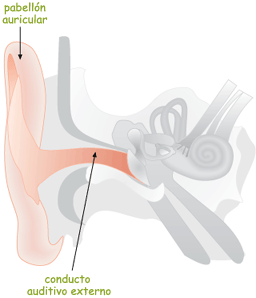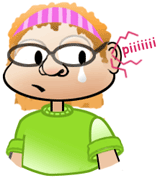Hearing noises, music, people’s voices, the referee’s whistle, sometimes mummy shouting.; hearing all these things is possible thanks to our ears.
Ears are incredible.They’re not just for hearing sounds. They also help us to stand, walk, not get giddy, that is, they help us to keep our balance.
Our ears hide secrets. They hide our sense of hearing. Come on in and find out for yourself!!!
But, oh dear! Sometimes our ears hurt. Have you ever had earache? It’s very painful, isn’t it? And somebody’s bound to have said at some time that you had O-TI-TIS. If you want to know why, we’re going to explain it to you now! The ears are truly a marvel of engineering.
Let’s take a look!!
External ear
|
|
Maybe you think the ear is this flap of funny skin called cartilage which you have on either side of your head. Yes, that’s an ear all right, but the ear we see is only a third of the whole ear. The rest is inside our skull.
The part you see is called the ear flap or auricle. The external ear picks up sound. |
Middle ear
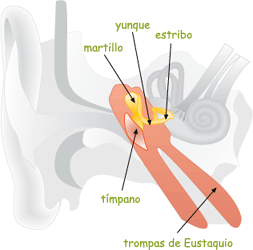 |
The middle ear is a chamber about the size of a chick-pea, which is separated from the external ear by a membraneas fine as cigarette paper. This membrane is the eardrum.
Then there are three tiny little bones called the malleus, the incus and the stapes. When sound reaches this membrane, that is the eardrum, the membrane vibrates and causes the tiny little bones to move, thus transmitting the sound to the inner ear. The air pressure in the inner ear is the same as the air pressure outside, which allows vibration to take place. The air enters this part of the ear through the Eustachian tubes, which connect it with the back of the nose. Sometimes, when you yawn and hear a little pop inside your ear, it’s because the Eustachian tube has sent out a small bubble of air to equalise the pressure. Why do our ears hurt when the aeroplane is taking off or landing? Why do we have wax-cerumen in our ears? |
Inner ear
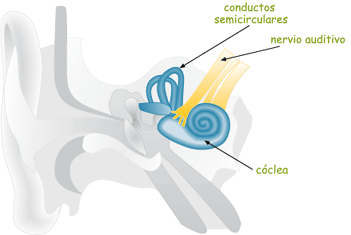 |
The inner ear transforms the vibration received by the eardrum into electrical signals and sends them to the brain; that’s how we hear sounds, voices, music, everything. This part of the ear is not cartilage, like the external ear, but a bony structure that contains different fluids which, by their movement, stimulate the nerve cells.
This part of the ear is also responsible for us keeping our balance. |
Otitis
Otitis is an infection that can affect both the inner and the external ear, and that can appear suddenly and be painful for just a few days, or it can start hurting gradually and carry on over a long period of time.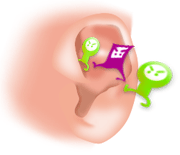
The bacteria responsible for the infection can enter the skin of the auditory canal through a small scratch on the ear caused by your nail, a biro or some other object such as a cotton bud for cleaning the ears, which can cause small lesions that irritate the skin.
Sometimes, as well as pain, otitis can also produce a little fluid.
Otitis is classified in different ways depending on the severity of the infection:
- Acute otitis externa
- Acute otitis media
- Secretory otitis
- Chronic otitis media
Sometimes otitis externa is called “swimmer’s ear”, because it can be caused by the constant contact of water with the ear.
So, if you often go swimming during the winter – or to the beach in summer -, you’ve possibly had otitis or “swimmer’s ear” more than once.
Your ears, or just one of them, can also hurt if you have a cold.
Otitis must be taken seriously, because it can lead to deafness.
Having otitis often is a nuisance.
Even though we’re talking about the ear, it’s worth knowing that it’s very important to blow your nose properly, and to always keep your nose clean.You must always blow out any phlegm, not sniff it inwards.
According to studies, it has been calculated that over 80% of children will have had secretory otitis before they are six.
Symptoms of otitis
There are different symptoms to indicate that you may have otitis:
|
|
|
Treatment of otitis
 |
The first thing to do when treating otitis is to zap the infection that is causing it.
The auditory canal must be cleaned very carefully, so that the medication (drops or ointments) can do its stuff. Sometimes, treatment may be completed with tablets. If the condition is very painful you can take painkiller tablets, and also relieve the pain by applying heat to the affected area. |
| When your ear hurts it’s very important not to mess about with it or scratch it with your finger or any other object.
When the infection has cleared up, when you no longer have otitis, you must always keep your ears clean and dry. And when swimming, if necessary, use earplugs. |
 |
Hygiene
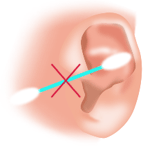 |
If you put your finger in your ear, you may come across a yellowish or brownish substance which is the earwax.This is formed from secretions of the sebaceous and ceruminous glands of the skin, along with hairs and dirt.
You must keep your ears clean and dry, but you must never use any cotton buds or other instruments for cleaning beyond the external ear. Earwax acts as a protection, lubricating the skin and preventing infection. In a way, you could say that ears have their own system of cleaning and disinfection. |
